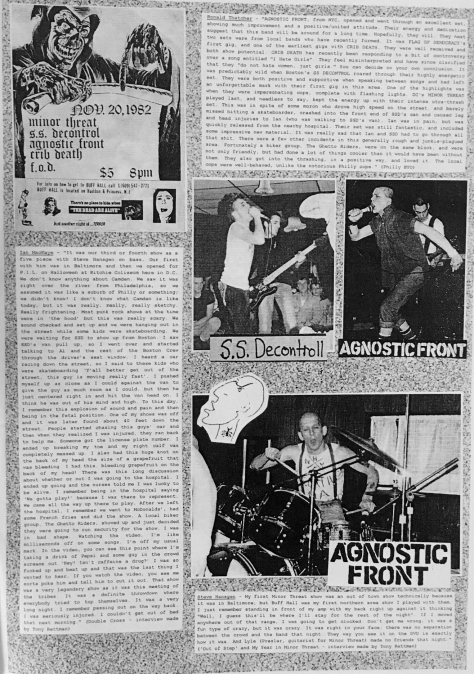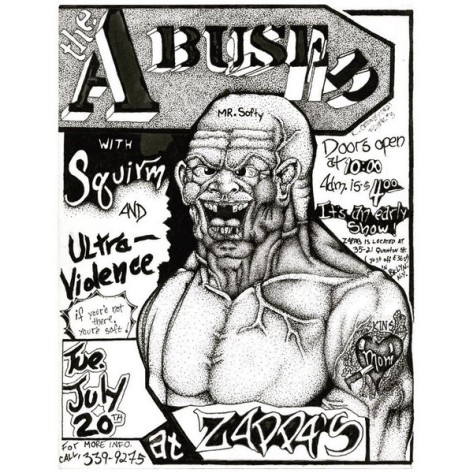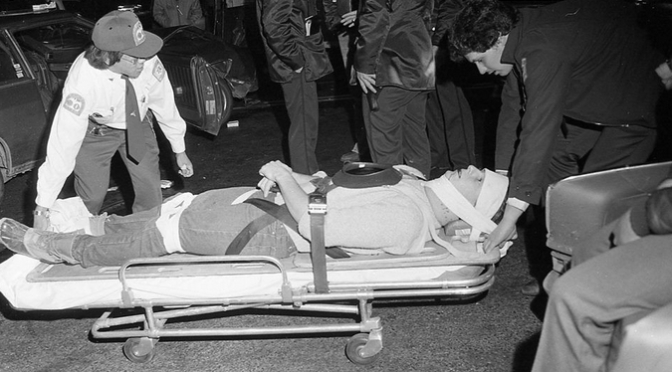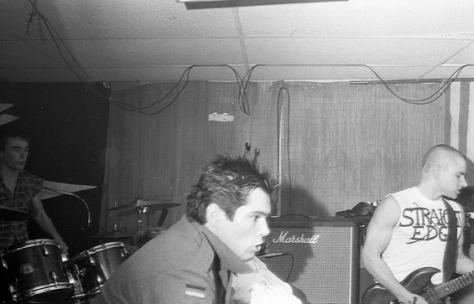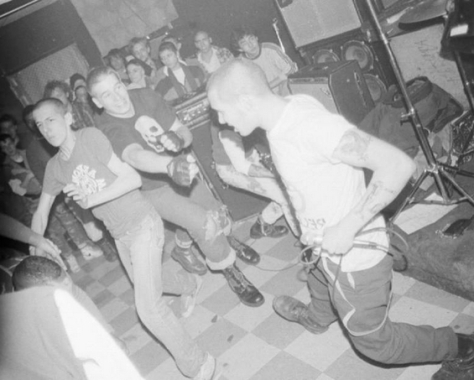This interview originally published in Chiller Than Most fanzine, issue 5 (2017). Photos by Cynthia Connolly, Bruce Rhodes, Phil N Flash, Allison Schnackenberg, Nancy Petriello Barile.

CTM – First off all, I hear that you are working on a book. Can you give us any details, can you give us a preview?
Nancy – I wrote a book two summers ago called Lessons from a Punk Rock Teacher, which basically told the story of how I use what I learned in punk rock in teaching. I got an agent right away, but he was unable to sell it – people either liked the punk rock story or the teacher story but not both. So I’m in the process of editing.
Preview:
I had read about the Cambodian gang problem in the Revere. I lived only a block from the notorious Shirley Avenue area, where gunfire and violence were commonplace, and I had been warned early on by nearly every friend and neighbor who knew I now lived in the area: “Do not walk down Shirley Ave. Not in the daytime and definitely not in the nighttime. Avoid it at all costs.” In the six years that I lived in Revere, I had never once been on Shirley Avenue even though it was so close to my home.
Now my classroom was filled with Cambodian students, many with homemade tattoos of Khmer lettering that read CAMBODIA or drawings of Angkor Watt and symbols of what I later learned represented the local neighborhood gangs. The Cambodian boys that populated my freshmen class looked much older than freshmen. They sat, unsmiling, in the back of the room in Dickies pants and Ben Davis shirts, buttoned only at the top, covering their tank top t-shirts. They sneered and rolled their eyes, and were certainly not interested in reading Great Expectations or TheOdyssey.
A few days after school started, another teacher poked her head into my room to say hi. “Oooh, you’ve definitely got some of the gang kids in your class,” she told me when she saw me later that day.
“Gang kids?” I asked. “They’re only freshmen.”
“B.R.D.” she explained. “Boston Red Dragons. It’s a Cambodian gang, and I think some of those kids are in it.”
My entire prior knowledge of gangs was culled from West Side Story and the movie Dangerous Minds, which I had seen that summer. I didn’t have a clue about real life gangs. However, since I had lived in the heart of Philadelphia for three years, I certainly was no stranger to violence. I considered myself fairly street smart, and I was sure I could find common ground to reach these alienated and marginalized kids. Maybe, I thought, being in a gang had similarities to punk rock. We had clothes and rituals that identified us. We were fiercely loyal to one another, and we considered ourselves to be tough and fearless. Maybe there were even some beliefs and interests we shared. In any event, I knew I had to reach these kids, and so I was determined to do whatever was necessary.
CTM – When will the book be released?
Nancy – I’ve been kinda lazy with the edits, and I work three jobs, so I’m hopefully going to give this some attention soon, and then seek out another agent and go from there. Sometimes I think maybe I need to write two separate books: a punk/hardcore one and a teaching one.

Nancy with Allison. She did a fanzine called Savage Pink, and they started the Philly BYO together with Ron Thatcher. Their first gig was at Buff Hall with Minor Threat, SSD, Agnostic Front, FOD.
CTM – Did you get into hardcore punk through metal, or did hardcore come first? Who were the bands that were the gateway for you to discover heavier and faster music?
Nancy – I grew up in the ’70s and my favorite musicians were David Bowie, Lou Reed, and Roxy Music. I also liked bands like Queen, Aerosmith, and Led Zeppelin. By senior year, I worshipped at the feet of Patti Smith, Iggy Pop, the Ramones, and Blondie, and become completely obsessed with punk rock. Punk rock took me took me to hardcore. I think that was a natural progression for many of us.
CTM – Did you have the classic punk look at that point in time?
Nancy – I did, actually. I bleached my light blonde hair white blond. I wore a leather jacket with the names of my favorite bands written in white marker on it. I wore jack boots. I liked the tough look of punk rock, and, especially after I moved to Center City Philadelphia, because I felt somewhat protected by it, as well.
CTM – What was the Philadelphia Better Youth Organization? Was hardcore popular in Philly at that time?
Nancy – So the BYO was started by Shawn Stern and his brother Mark, who were in the band Youth Brigade from California. The premise of BYO was to promote punk and alternative youth cultures in a positive light. Their motto was „that every generation has a responsibility to change what they feel is wrong in the world.” Allison Schnackenberg (Savage Pink), Ron Thatcher, and I from Philly thought that was a pretty great idea, and we wanted to start a BYO in Philly. Shawn was my friend, and so I asked him if we could start a Philly chapter, and he gave us his blessing.
Hardcore was huge in Philly. It was a major stop for all the best hardcore bands, and Philly produced some great bands on its own, as well.
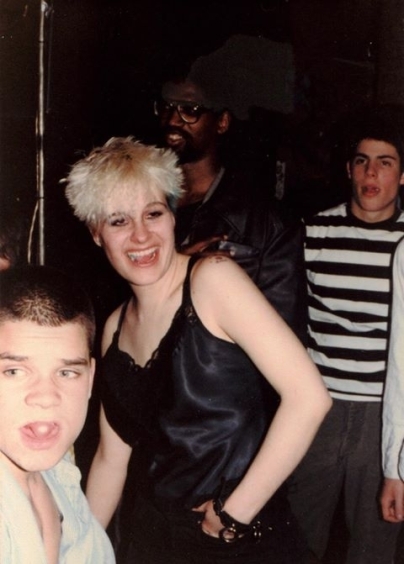
Nancy with Harley Flanagan, 1981.
CTM – As far as I know, you were a fan of early New York hardcore bands like the Mob, Kraut, Reagen Youth. The Kraut “Unemployed” 7 inch is really awesome, I think that very few bands pulled off the perfect mix of UK punk and US hardcore that Kraut did so well. What are your memories about Kraut?
Nancy – I loved Kraut and agree with you that they had a great sound. I listened to their Unemployed 7 inch SO MUCH back in the day. I saw them play quite a few times, and they never disappointed. I probably saw the Mob play the most. I loved the guys in that band – they were so incredibly nice and fun and just so easy-going.
CTM – Ronald Reagan won the presidency in 1980 and he became the galvanizing force of hardcore. Music and art changed radically from 1980 to 1986 when he was in his prime. Someone said that “everyone got into punk bands because of him.” At the time of being hardcore/punk teenager how dis you live through this era and what are your memories about the band Reagen Youth?
Nancy – I felt extremely frustrated because at the time, I was uneducated and didn’t understand politics and government the way I wanted to. I culled a lot of my information from the bands that I loved – everyone from the Dead Kennedys to Crass. I went to the Philadelphia Public Library and took out books by Hannah Arendt and read The Meaning of Democracy by Russell, William, and Thomas Brigg.Reagan Youth were a great band, who I had the pleasure of seeing live. Those guys were very cool, and I liked listening to them talk.

CTM – What about other bands you saw there, were there any bands that you were really into?
Nancy – NYC in the very early days didn’t really have a strong hardcore scene – just the Mob, and maybe Kraut, although at the time, I think I considered them and bands like Reagan Youth more punk. I was good friends with John Watson, and he was the first singer of AF, so, of course, I loved AF when they came on the scene. Jimmy G was in a band called Cavity Creeps, and Jimmy was always a strong front man. I also enjoyed The Young and the Useless.
CTM – Most hardcore punk rehearsal studios, squats, clubs were in the worst areas of NYC, so going to a show alone was a huge commitment and risk. What are your fave memories of the legendary A7 and 171A? What was the main difference between A7 and 171A?
Nancy – Well, New York was a warzone back then, but I had no fear of death. When I think how I used to walk the 63 blocks from Penn Station (a few times by myself) down to A7, 171A, and CBGBs, I can’t believe it. I have a great story about being at 171A and seeing MDC, I think. This NY girl, Lazar and I went around the corner to get an Orange Crush, and when we got back, we saw the cops were arresting everyone in front of the place. We pulled a fast one by making a phone call that got the cops to leave. We were a bit dishonest, but we saved the day, and everyone bought us beers the rest of the night. I liked 171A better than A7 because I think it was a bit bigger, and I saw more shows at 171A than I did at A7. I think I only saw like one show at A7.
After I met Al in Staten Island we lost touch for a couple of weeks. Then I went to see MDC at 171. I called Al and asked him if he was going to that show. He was. We met at St. Mark’s – maybe at Bleeker Bobs or something. That night kinda solidified our relationship, so that’s a fond 171A memory.
CTM – Are there any particular A7 gigs that stuck in your memory? One of my favourite hardcore photos was taken at A7 in 1982. SS Decontrol on the “stage”, and if we look closely in the audience we can find MCA of the Beastie Boys, Jimmy Gestapo of Murphy’s Law, Dr. Know of Bad Brains etc.
Nancy – Sadly, I wasn’t at that show! And my memory regarding those shows is weak – I don’t even remember which bands I saw at A7 and which ones I saw at 171A. The two or three concussions I sustained during my hardcore years have definitely adversely affected my memory.

CTM – Irving Plaza, NYC 05.15.1982. – Minor Threat, Bad Brains, Double O.
After temporarily breaking up in late 1981, Minor Threat reformed in April of 1982 and began writing what would eventually become the all-time classic Out of Step record. Wanting to test out this new record, they traveled north to perform at Irving Plaza in NYC on May 15th. The stage was crowded with rowdy New York and Boston hardcore punks from the second the music began resulting in total chaos. Harley Flanagan and the Boston Crew are amongst many that can be heard singing along. Ian Mackaye delivers some snide stage banter, we also hear Ian telling Harley Flanagan to quit sitting on the stage. Haha!
What was your favourite Irving Plaza gig and why? I know that later this year Minor Threat played at Irving Plaza again, SS Decontrol was on the bill, too.
Nancy – The Bad Brains are my all-time favorite band, and I was positively obsessed with them. I’d go anywhere in a tri-state area region to see them. Their Irving Plaza show was amazing. But I think my favorite Irving Plaza show was that Minor Threat – SS Decontrol show. There was so much energy in the air; I was madly in love with Al, and I was planning on moving to Boston. Both bands played siege-like sets and the energy in the room was unbelievable.

CTM – Agnostic Front, SS Decontrol, Minor Threat. How was the legendary Buff Hall show in November, 1982? I read that earlier you were tired and frustrated with of all the schisms between New York and Boston and Philly and DC.
Nancy – Before I left Philly to move to Boston, I needed to do one more show. As I stated, Allison, Ron Thatcher, and I had worked with Shawn Stern from the Better Youth Organization in L.A. to try to create a BYO in Philly. After Shawn gave us his blessing to replicate his BYO model, we began to plan our first show. We were tired and frustrated with of all the schisms between New York and Boston and Philly and D.C., and we hoped to bring everyone together in a hardcore love fest, so we decided our show would feature bands from up and down the East Coast. We asked Crib Death and Flag of Democracy from Philly, Agnostic Front from New York, SS Decontrol from Boston, and Minor Threat from DC to play the show. At the time, I don’t think we realized what a powerhouse line-up we had just built. Ian MacKaye later called it “a gathering of the tribes.”

Christine Elise McCarthy, Nancy, Ian at the Channel June 12, 1983.
CTM – You organized a show for the Bad Brains at Elks Center in January 82. A few years ago, I was lucky to hear this live set, and this is one of the best live Bad Brains sets I’ve yet to hear. Would you mind sharing some interesting stories/memories about this gig?
Nancy – I actually didn’t organize that show at the Elks Center – Austistic Behavior did. As you get older, your memory can play tricks on you, and I reconnected a few years ago with Craig Surgent from Austistic Behavior, and he pointed out that the ABs did the Bad Brains and I did Black Flag (with WXPN dj and scene leader, Lee Paris). But I can tell you about that Bad Brains show. The guys in Autistic Behavior were always talking about how awesome the Bad Brains were. I believed them to a certain extent, but NOTHING could have prepared me for seeing them at that Elks Center show. I remember being in the back of the hall when they started Big Takeover, and just being pulled to the front of the stage. I never saw/heard anything like it. First of all, they were incredible musicians, and they were fast AND powerful. There was never a better frontman than H.R. when he was ON. Their songs were structured so well, and when I listened to them, I had a positively physical response – like I just wanted to jump out of my skin. I was so blown away! As I said, I become obsessed, and saw them everywhere they played in New York, New Jersey, and PA after that.
CTM – Was there a band you wanted to book to play a show but never got the chance?
Nancy – Well, I booked Black Flag, and I booked (with Allison and Ron) Minor Threat, SSD, and Agnostic Front. I booked a lot of Philly bands. I guess I would have liked to actually have booked the Bad Brains – that’s probably why I revised history in my head haha.

Nancy and Al
CTM – SS Decontrol was obviously very influenced by what was going on in DC. Minor Threat had a strong influence on the hardcore scene, both stylistically and in establishing a DIY ethic for music distribution and concert promotion. What is your opinion?
Nancy – My personal DIY came long before I had even heard of MT. When I moved to Center City Philadelphia and figured out that I couldn’t see the bands that I loved because they weren’t playing stadiums or they were playing bars I was too young to get into, I knew we had to do something. I started doing shows with Sadistic Exploits, the band I managed in ’80 and ’81. We did two Punk Fests at the Elks Center with local bands, and huge crowds came out for them. I think that was the case with many scenes across the country. We all realized that if we wanted to see the bands that we liked, we were going to have to do the shows ourselves. I would not attribute the DIY ethic to any single place or band.
CTM – SSD got started by Al Barile in the summer of 1981, they first gigged September 19, 1981 at the Gallery East. This club was one of the first venues to host hardcore punk rock shows for an all-ages audience. Al, at that time when SS Decontrol started playing at the Gallery East, did you see any hope for the straight edge hardcore scene?
Al – The point was what I saw in Boston was a music scene that wasn’t geared towards the music that I thought kids liked, and it was very frustrating for me to see a music scene that had zero connection with the kids. So I had to try.

CTM – Al, you said in an interview that the Boston punk scene was a congregation of drugged-out losers. That was the direct opposite of their values and what they were trying to do. What were the reactions after “The Choice” leaflet?
Al – I don’t even know how many people saw that, but I didn’t sense any change. And the truth is that even during the whole thing, there wasn’t a huge focus on straightedge. I felt there were a lot of bands that kind of stayed away from the subject.
CTM- Jon Anastas said that Boston has always had flinty, old-school work ethic. It’s in their blood and they ran with it because whatever the Boston crew did, they were all in. Professionalism and precision. What do you think about this?
Al – I don’t know that I think Boston has a stronger work ethic than anywhere else. We always tried to put on the best show we could.
CTM – I often hear criticisms or perceptions that DYS always seemed a few months behind SS Decontrol. What is your opinion about this topic?
Al – I never looked at it that way. I think they were on pace with their own development. We were two separate bands, and there really wasn’t much discussion about each other’s development.

CTM – What was the story behind the song called “How Much Art”? Al once said in an interview that it was a joke song, it’s not to be taken seriously.
Al – It’s not a „joke song” – it was about the music scene in Boston. It’s not about a canvas on a wall. It’s about the direction of the music scene.
CTM – Homemade “The Straight Edge” jacket, DIY t-shirts, DIY SSD pins, concrete block holding the bass drum, classic Boston crew “Sleeve cap”… Every object of this era helps us to understand the special habits and traditions of the early Boston hardcore. What were your fave objects?
Nancy – For me, Al gave me his Straight Edge jacket fairly early on in our relationship. It was the first present he gave me, and I treasured it – which is why I still have it after all these years haha.
Al – I was never into trinkets. I guess I liked guitar picks.
CTM – Many years ago I got a cassette with a SS Decontrol radio interview. I know that this radio interview was recorded when the band had only been together for two months. Boston was a college radio hotbed, in the early 80s WERS and WMWM supported hardcore. Where was the interview made? What are your memories?
Al – We did two radio interviews early on WERS and WMBR, and I think WMBR was first and WERS was second. Katie the Kleening Lady set the WERS one up.

CTM – Boston’s legendary hardcore punk label, X-Claim! Records label was owned and ran by Al. The design of the X-Claim! releases could summarize the aesthetic of that era in hardcore. Bridget Burpee was involved in the artwork of five out of the six X-Claim’s seminal outputs, she did the graphic art of the whole SS Decontrol “The Kids Will Have Their Say” LP, DYS “Brotherhood” LP, F.U.’s ?”My America” Lp etc. Please tell me something about her, I was always curious who she was. Was she a professional graphic designer? What do you think about her style?
Nancy – Bridget Burpee Collins is one of the most badass women I know. And yes, she was and is a total professional. She is an extremely talented artist, who has worked in so many fields from graphic design, to culinary arts, to real estate. She succeeds in all that she does. I LOVE her style, and I know that she captured the exactly what Al wanted. If you look at Al’s early flyers, he had a very distinct style, and he was responsible for the X with the letters in it, which several scenes and bands have used (NYHC). Bridget and I are still friends today. She’s married to Richie Collins from Negative FX.We all just had dinner (Angie and Jaime (SSD), Bridget and Richie, and Al and me.)
CTM – Last year I read a funny “How We Rock” story. After Al Quint (“Suburban Voice” fanzine) published his negative review about the SSD record, he got a call at his apartment from a woman who didn’t identify herself but took issue with the review. Was this you? What’s the full story?
Nancy – Haha! I never heard that story, and no, it was definitely not me. That is completely not my style. I actually emailed Al Quint after I read this question to ask him if this was a true story because I didn’t believe it when I read it. He said he believes heDID get the call, and he always thought it was me. I can assure you that if I ever called anyone up to bitch about something, I’d identify myself. Neither Al nor I cared much about reviews, though – everyone is entitled to his/her opinion. I did, however, call some record stores when they were selling bootleg SSD records and threatened them with legal action, and that got pretty nasty. I was a paralegal at a law firm at the time, and the lawyers at my firm were willing to back me, so I was pretty crazy on those phone calls.

CTM – Thanks for your time Nancy, I really appreciate your support. Last words? How do you feel about SS Decontrol’s legacy today?
Al – I’m proud to do whatever we did, wish I could have done more. Wish more people had a chance to see us. I’m happy and proud that the band was able to write some memorable riffs or songs because that’s essentially what it’s all about.
Nancy – Like many women who were integral to the early hardcore scene, I frequently lament that our voices are not often heard in the retelling of the history. That is something I never cared about until recently – like the educator, documentarian, and feminist in me now wants the history told correctly. I remember when the guys who did American Hardcore came to Al’s house to interview us. I was excited because I thought they were going to interview me about my work as a manager and promoter in both Philly and Boston, but basically, I was just seen as Al’s wife. But later Steven Blush did interview me for the 2nd edition of American Hardcore, so I was happy about that. Women may have been outnumbered in the hardcore scene, but many of us played important roles on stage and behind the scenes, and I’m always happy to have the opportunity to set the record straight.







